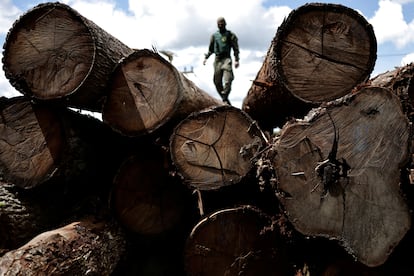In Latin America, more than 1.1 million people have been displaced by climate change
According to the Environmental Impunity Index, the region fails to protect its ecology. Only 0.18% of the total GDP of Central and South America is invested in mitigating the climate crisis

The University of the Americas Puebla (UDLAP) — a private Mexican university — examined the 33 countries in Latin America and the Caribbean. A group of researchers carefully analyzed — on a country-by-country basis — what the region is doing to mitigate climate change and facilitate access to climate justice. The results turned out to not be as ambitious as the critical situation demands.
According to the 2023 Environmental Impunity Index — presented this past Wednesday in the Senate of Mexico — the average performance score is 54.86 out of 100. The region invests only 0.18% of overall GDP into preserving the environment, despite the fact that global warming hits Latin America and the Caribbean in a disproportionate manner. “This lack of financing reflects the lack of political will,” laments Azucena Cháidez Montenegro, a co-author of the index. “While there’s consensus about the need to act, the institutional response lacks teeth, it lacks resources.”
The index notes that climate migration is the most pressing consequence stemming from the lack of political will to take climate action. According to data collected by a census report prepared in 2021, at least 1.18 million people in the region have been internally displaced due to climatic factors. Brazil is at the top of this list: almost half-a-million people have migrated internally due to climate-related disasters. In Haiti, the figure is around 220,000. In Cuba and Uruguay, it’s 194,000 and 160,000 respectively. For Celeste Cedillo — a professor at UDLAP and a co-author of the index — these figures “are very scary” and she warns that the data indicates that the number of climate displaced people “will grow more and more.”
Institutional capacity is one of the most disparate parameters studied between countries, according to the index. Bolivia (58.8), Mexico (56.6) and Brazil (54.97) obtained the best performance, while Haiti (14.71), Saint Vincent (13.27) and Trinidad and Tobago (8.41) were the worst-rated in this category. In the research, Cháidez explains, they worked hard to shape scales that could compare countries such as Brazil and Barbados, which have very different population densities, budgets and political factors. The objective of the index is to put all countries in front of a mirror and draw a roadmap for the optimization of public policies and environmental justice.
The enormous gaps between one nation and another warn of the high levels of vulnerability and inequality that countries in the region — which have little state muscle when it comes to environmental matters — are subject to. “Latin America is an incredibly unequal region, [especially in rural areas]. This has a direct impact on the social effects of the environmental crisis,” the accompanying report reads.

Mexico’s environmental failure: good policies, bad results
Although larger countries have better institutional capacity, they score very poorly when it comes to environmental degradation and crimes. The Commonwealth of Dominica (71.54), Panama (70.92) and Saint Vincent (70.21) are in the best positions, while Brazil (53.95), Barbados (52.9) and Mexico (45.35) occupy the last spots. This result warns that countries with greater resources cannot necessarily make them function effectively, nor fully guarantee their citizens’ right to a healthy environment. For Celeste Cedillo, the most paradigmatic example of this is Mexico: “It has good federal [environmental] policies, but it fails to ground them at the subnational level. That is, the results aren’t seen at the local level. It’s a very obvious failure.”
Mexico also faces environmental conflicts, which range from the murders of environmentalists to territorial disputes linked to extractivism. Mexico, Brazil and Colombia are the countries with the most environmental lawsuits in the region. These three countries represent 49.8% of the total number of conflicts, with Mexico being the country with the most in the region, at 19.8% of the total. Latin America as a whole, meanwhile, has the dishonorable title of being the deadliest region in the world for environmental activists. Nine out of 10 of the violent deaths of these activists take place in Latin America and the Caribbean. Since 2012, this represents a total of 1,910 people.
The lack of legal protection is also a weak point in the region. 63.6% of the countries studied don’t explicitly recognize the right to a healthy environment in their constitutions, while only 9% of Carribean, Central and South American countries have courts that specialize in environmental matters.

All of these deficiencies contribute to the term “environmental impunity”
“These aren’t just crimes that haven’t been solved,” Cháidez clarifies by phone. “[They haven’t been solved] because there’s no law, or it cannot be applied. It has to do with the inability of the state to generate legislation, policies or resources.”
After analyzing more than 50 variables, the index divides the 33 countries of Latin America and the Caribbean into three large groups, according to their score. Those with medium-low impunity have the best scores (from 64.76 to 59.42) and are: Chile, Ecuador, Costa Rica, Colombia, Argentina, Dominican Republic, Uruguay, Bolivia, Peru, Nicaragua and Panama. They’re followed by Venezuela, Mexico, Dominica, El Salvador, Brazil, Cuba, Guyana, Saint Kitts and Nevis, Guatemala, Bahamas and Barbados. And finally, there are the nations with the worst ratings: Honduras, Saint Lucia, Jamaica, Antigua and Barbuda, Belize, Paraguay, Grenada, Haiti, Saint Vincent and the Grenadines, Trinidad and Tobago and Suriname.
Cháidez bemoans the particularly poor performance of smaller countries or those with more poverty, since they’re the ones that face the highest levels of risk and vulnerability stemming from climate change. This is despite the fact that they only minimally contribute towards harmful greenhouse gas emissions. Experts are urging for greater technical assistance to these small, low-income countries, as well as assistance to help them formulate public policies, processes of institutional change and risk management, and evidence-based systems of prevention and climate adaptation.
The lack of data is a big problem across the board, resulting in a lack of comparable information from one country to another. This is — for both experts consulted in this report — the biggest Achilles’ heel in Latin America. Both indicated that they had to resort to information from civil society organizations that collect data “as a response to the institutional vacuum.”
“Not reporting the information is keeping [environmental] impunity alive,” Cháidez sighs. “This only brings obscurity to processes that have to be evaluated and monitored. And we’ve realized that states aren’t taking the task of documenting what they do seriously.”
Sign up for our weekly newsletter to get more English-language news coverage from EL PAÍS USA Edition
Tu suscripción se está usando en otro dispositivo
¿Quieres añadir otro usuario a tu suscripción?
Si continúas leyendo en este dispositivo, no se podrá leer en el otro.
FlechaTu suscripción se está usando en otro dispositivo y solo puedes acceder a EL PAÍS desde un dispositivo a la vez.
Si quieres compartir tu cuenta, cambia tu suscripción a la modalidad Premium, así podrás añadir otro usuario. Cada uno accederá con su propia cuenta de email, lo que os permitirá personalizar vuestra experiencia en EL PAÍS.
¿Tienes una suscripción de empresa? Accede aquí para contratar más cuentas.
En el caso de no saber quién está usando tu cuenta, te recomendamos cambiar tu contraseña aquí.
Si decides continuar compartiendo tu cuenta, este mensaje se mostrará en tu dispositivo y en el de la otra persona que está usando tu cuenta de forma indefinida, afectando a tu experiencia de lectura. Puedes consultar aquí los términos y condiciones de la suscripción digital.
More information
Archived In
Últimas noticias
Most viewed
- Reinhard Genzel, Nobel laureate in physics: ‘One-minute videos will never give you the truth’
- Oona Chaplin: ‘I told James Cameron that I was living in a treehouse and starting a permaculture project with a friend’
- Pablo Escobar’s hippos: A serious environmental problem, 40 years on
- Why we lost the habit of sleeping in two segments and how that changed our sense of time
- Chevy Chase, the beloved comedian who was a monster off camera: ‘Not everyone hated him, just the people who’ve worked with him’











































